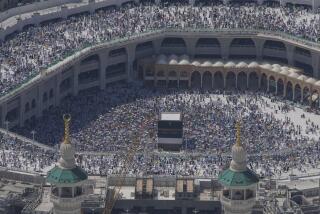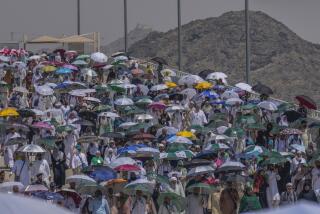20,000 Pilgrims Stricken as Sun Takes Its Toll on Crowd
- Share via
DENVER — World Youth Day, a four-day gathering of Roman Catholics from about 70 nations, drew to a chaotic close Sunday with at least 20,000 people being stricken in sweltering heat over the last two days after a 14-mile trek, an all-night prayer vigil and a lengthy outdoor Mass.
Even as Pope John Paul II was concluding his final Youth Day Mass for an estimated 350,000 people jamming Cherry Creek State Park, worshipers, some of them unconscious, were being hustled on stretchers, blankets and sleeping bags to makeshift field clinics at the rate of 500 an hour.
Most were treated for nosebleeds, sprained ankles, dehydration, nausea and complications, including hallucinations. One woman was taken to a local hospital after she went into labor. Another woman suffered seizures and remained in serious condition.
Still others reportedly suffered heart attacks, strokes and seizures Sunday, but details on their condition were not immediately unavailable.
The sheer volume of people suffering heart attacks, strokes, heat exhaustion and sunstroke prompted local law enforcement and medical authorities to accuse organizers of inadequate planning and preparation.
One Denver-area man, Willie Paiz, 61, died of cardiac arrest late Saturday after collapsing at the park.
“It’s a war zone--to say that we are overwhelmed is an understatement,” said Denis Meade, a paramedic heading up operations at one of the numerous tent clinics ringing the shadeless, 120-acre Mass site southeast of Denver. “I think World Youth Day owes a big apology to the medical community and its own participants.”
Sister Mary Ann Walsh, director of communications for World Youth Day, downplayed the severity of the medical problems.
“I wish that 2% of the young people had not had their wonderful experience marred by succumbing to heat,” Walsh said. “You can lead the youth to water, but you can’t make them drink.”
So fast were young and old alike keeling over in 90-degree heat that paramedics had to administer fluids intravenously to some victims wedged like sardines at the center of the dust-choked field.
Nearby, in the shade of a green military-issue tent, Rachel Spraberry, 14, of Memphis, Tenn., was bundled in a blanket despite the steaming heat and was trying to gulp down as much water as she could.
“I came to see the Pope, but I would rather be home more than anything right now,” said the teen-ager, one of more than 80,000 people who made the 14-mile trek from Denver to the park on Saturday and stayed overnight for the Pope’s Mass. “We had fun up until now.”
Half a mile away, at another emergency treatment center, paramedics and volunteers were racing to erect more tents donated by the McDonald’s restaurant chain and calling in ambulances to transport hundreds of the most seriously ill to a temporary recovery center just outside the park.
Many in the crowd were mystified that the Mass participants seemed oblivious to the suffering around them. At one point during the 3 1/2-hour Mass, paramedics pleaded for a parade of 20 white-robed priests serving Communion to move from the path of emergency vehicles ferrying stricken worshipers.
Many of the medical problems were attributed to visitors unaccustomed to the city’s mile-high altitude, combined with temperatures that have soared into the low 90s.
Beyond that, medical authorities said, ordinarily healthy young people were overtired from four days of exhausting activities, and many had gotten little sleep and were not eating regularly or drinking enough water for such an arduous hike.
Arapahoe County Sheriff Pat Sullivan said the seeds of Sunday’s disaster were sown last week when tens of thousands of World Youth Day participants flooded Denver.
“Putting thousands of kids up in parking garages and in the National Western Stock Show yards with very poor water, sanitation and eating conditions prepared the recipe for today,” Sullivan said. “This will be criticized for months.”
Sahagun is The Times’ Denver Bureau chief and Lindgren is a special correspondent. Times researcher Ann Rovin contributed to this story.
More to Read
Sign up for Essential California
The most important California stories and recommendations in your inbox every morning.
You may occasionally receive promotional content from the Los Angeles Times.














